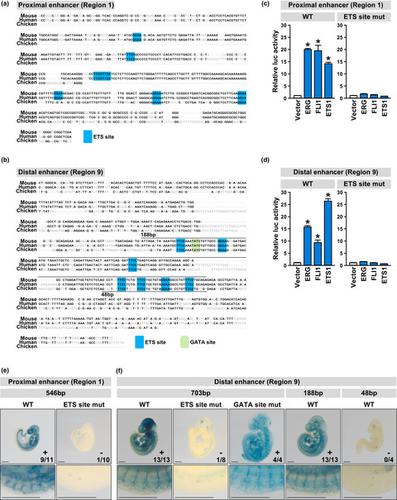当前位置:
X-MOL 学术
›
Genes Cells
›
论文详情
Our official English website, www.x-mol.net, welcomes your feedback! (Note: you will need to create a separate account there.)
ETS-dependent enhancers for endothelial-specific expression of serum/glucocorticoid-regulated kinase 1 during mouse embryo development
Genes to Cells ( IF 2.1 ) Pub Date : 2021-06-03 , DOI: 10.1111/gtc.12874 Yukihiro Harada 1, 2 , Toru Tanaka 1 , Yuji Arai 1, 3 , Yoshie Isomoto 3 , Atsushi Nakano 3 , Shu Nakao 2 , Akihiro Urasaki 1 , Yusuke Watanabe 1 , Teruhisa Kawamura 2 , Osamu Nakagawa 1
Genes to Cells ( IF 2.1 ) Pub Date : 2021-06-03 , DOI: 10.1111/gtc.12874 Yukihiro Harada 1, 2 , Toru Tanaka 1 , Yuji Arai 1, 3 , Yoshie Isomoto 3 , Atsushi Nakano 3 , Shu Nakao 2 , Akihiro Urasaki 1 , Yusuke Watanabe 1 , Teruhisa Kawamura 2 , Osamu Nakagawa 1
Affiliation

|
Serum/glucocorticoid-regulated kinase 1 (SGK1) is predominantly expressed in endothelial cells of mouse embryos, and Sgk1 null mice show embryonic lethality due to impaired vascular formation. However, how the SGK1 expression is controlled in developing vasculature remains unknown. In this study, we first identified a proximal endothelial enhancer through lacZ reporter mouse analyses. The mouse Sgk1 proximal enhancer was narrowed down to the 5’ region of the major transcription initiation site, while a human corresponding region possessed relatively weak activity. We then searched for distal enhancer candidates using in silico analyses of publicly available databases for DNase accessibility, RNA polymerase association and chromatin modification. A region approximately 500 kb distant from the human SGK1 gene was conserved in the mouse, and the mouse and human genomic fragments drove transcription restricted to embryonic endothelial cells. Minimal fragments of both proximal and distal enhancers had consensus binding elements for the ETS transcription factors, which were essential for the responsiveness to ERG, FLI1 and ETS1 proteins in luciferase assays and the endothelial lacZ reporter expression in mouse embryos. These results suggest that endothelial SGK1 expression in embryonic vasculature is maintained through at least two ETS-regulated enhancers located in the proximal and distal regions.
中文翻译:

小鼠胚胎发育过程中血清/糖皮质激素调节激酶1的内皮特异性表达的ETS依赖性增强剂
血清/糖皮质激素调节激酶 1 (SGK1) 主要在小鼠胚胎的内皮细胞中表达,Sgk1缺失小鼠由于血管形成受损而显示胚胎致死率。然而,在发育中的脉管系统中如何控制 SGK1 表达仍然未知。在这项研究中,我们首先通过lacZ报告小鼠分析确定了近端内皮增强剂。鼠标Sgk1近端增强子缩小到主要转录起始位点的 5' 区域,而人类相应区域的活性相对较弱。然后,我们使用公开可用数据库的 DNase 可及性、RNA 聚合酶关联和染色质修饰的计算机分析来搜索远端增强子候选物。距离人类SGK1基因约 500 kb 的区域在小鼠中是保守的,并且小鼠和人类基因组片段将转录限制在胚胎内皮细胞中。近端和远端增强子的最小片段具有 ETS 转录因子的共有结合元件,这对于荧光素酶测定和内皮lacZ 中对 ERG、FLI1 和 ETS1 蛋白的反应至关重要小鼠胚胎中的报告基因表达。这些结果表明,胚胎脉管系统中的内皮 SGK1 表达是通过位于近端和远端区域的至少两个 ETS 调节的增强子维持的。
更新日期:2021-08-10
中文翻译:

小鼠胚胎发育过程中血清/糖皮质激素调节激酶1的内皮特异性表达的ETS依赖性增强剂
血清/糖皮质激素调节激酶 1 (SGK1) 主要在小鼠胚胎的内皮细胞中表达,Sgk1缺失小鼠由于血管形成受损而显示胚胎致死率。然而,在发育中的脉管系统中如何控制 SGK1 表达仍然未知。在这项研究中,我们首先通过lacZ报告小鼠分析确定了近端内皮增强剂。鼠标Sgk1近端增强子缩小到主要转录起始位点的 5' 区域,而人类相应区域的活性相对较弱。然后,我们使用公开可用数据库的 DNase 可及性、RNA 聚合酶关联和染色质修饰的计算机分析来搜索远端增强子候选物。距离人类SGK1基因约 500 kb 的区域在小鼠中是保守的,并且小鼠和人类基因组片段将转录限制在胚胎内皮细胞中。近端和远端增强子的最小片段具有 ETS 转录因子的共有结合元件,这对于荧光素酶测定和内皮lacZ 中对 ERG、FLI1 和 ETS1 蛋白的反应至关重要小鼠胚胎中的报告基因表达。这些结果表明,胚胎脉管系统中的内皮 SGK1 表达是通过位于近端和远端区域的至少两个 ETS 调节的增强子维持的。



























 京公网安备 11010802027423号
京公网安备 11010802027423号